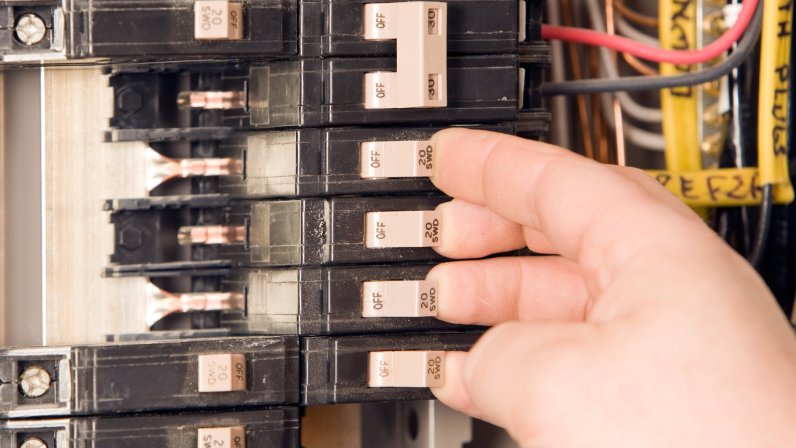A circuit breaker is an actually important part of modern circuits and one of the most vital safety mechanisms in our houses. Whenever electrical systems in a building have too much current flowing within their wiring, these simple devices cut the energy until somebody can resolve the problem.
How does a Circuit Breaker Work?
Without circuit breakers (or other cut-off devices like a fuse), household electricity would be in a dangerous situation due to the potential for fires and other harm resulting from the fundamental wiring problems and the instruments’ failures. In this post, we will answer this main question: how does a circuit breaker work? We will also find out how a circuit breaker detects electrical current and how it cuts off the energy when current rates get too great. As we’ll see, the circuit breaker is an absolutely simple method to a practically deadly problem.
Introduction
The arrangement of power distribution delivers electricity from the main source like a power plant to our home. Inside the home, the electric current flows in a large diagram, which is contained in several smaller circuits. One end of the system, the hotline, leads to the power plant. The other end, introduced as the neutral line, leads to the ground. Because the hotline combines to a great energy resource, and the neutral line combines to an electrically neutral section (like the earth), there is a voltage within the circuit, and the charge flows whenever the circuit diagram is closed. In this section, the current is introduced as the alternating current because it immediately changes direction.
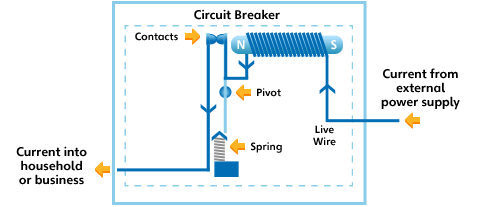
The power distribution section sends electricity at a constant voltage (typically 120 or 230 volts), but resistance and, as a result, the current change in the home. All of the different electrical appliances and light bulbs provide a certain value of resistance, also introduced as the main load. This value is what makes the appliance operate. For example, a light bulb has a filament in its center that is too resistant to the moving charge. The charge should operate hard to move along, which warms up the filament, causing it to light.

In the house wiring, the hotline and the neutral line never touch directly. The charge flowing within the circuit often passes through an electrical appliance, which behaves as a resistor. In this case, the electrical resistance in the particular appliance restricts how much charge can move in the circuit (with a fixed voltage and a fixed resistance, the current should also be fixed). Appliances are constructed to keep the current at a comparatively low rate for safety aims. Too much charge moving within a circuit at a particular period would warm the appliance’s lines and the house wiring to unsafe rates, potentially causing a fire.
This keeps the electrical device operating for most of its lifetime smoothly. But occasionally, something will combine the hotline directly to the neutral line or something else leading to GND (Ground). For instance, the motor of a fan might overheat and melt, joining the neutral and hot wires together. Or someone might drive a pitch into the home’s wall, suddenly puncturing one of the power wires. When the hotline is combined directly with GND, there is minimum resistance in the system, so the voltage pushes a great value of charge within the wire. If this continues, the power lines can overheat and begin a fire.
The circuit breaker’s task is to cut off the system whenever the current jumps more than a specific safe rate. In the following sections, we’ll discover how it does this clearly. If you want to explore more about the operation of a circuit breaker, visit here.
The Circuit Breaker Design: Basic
The simplest circuit protection instrument is the fuse. A fuse is just a smooth wire, covered within a casing, that plugs into the system. When the system is closed, all charge moves within the fuse wire. The fuse experiences an equal current like any other point along with the diagram. The fuse is constructed to disintegrate when it warms up above a specific value. If the current increases too high, it burns up the line. Destroying the fuse opens the system before the additional current can harm the system wiring.
The problem with such fuses is that they just perform once. Every time a fuse is not performed, you should replace it with a new one. A circuit breaker works on the same principle as a fuse. It opens the circuit immediately as soon as the current rises close to the unsafe rate, but you can employ it again contrary to the fuse. The usual circuit breaker includes a simple switch attached to either an electromagnet or a bimetallic strip. The diagram below shows a typical electromagnet design.
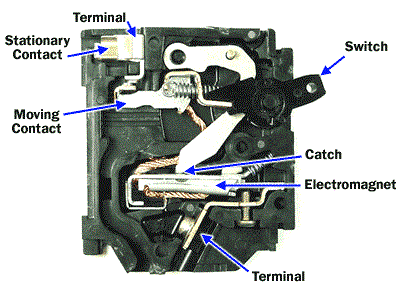
The hotline in the system combines the two sections of the switch. When the system is switched to the On position, electricity can move from the below terminal, within the electromagnet, up to the sliding contact, across to the main contact, and out to the next terminal.
The electricity stimulates the electromagnet section. Increasing current improves the EMF value (Electromagnet’s Magnetic Force), and decreasing current reduces the magnetism. When the current rises to an unsafe rate, the electromagnet is high enough to pull down the mechanic part (like the metal blade) to the switch linkage. The total linkage changes, tilting the sliding contact away from the main contact to break the system. As a result, the electricity cuts off.
Then, you push the circuit breaker to release the main switch. A bimetallic strip model operates based on the same method, except that instead of improving the electromagnet, the main current bends a particular strip to push the linkage. Some circuit breakers employ an additional charge to change the switch. When the current increases above a particular rate, it plugs the explosive substance, which uses a piston to open the main switch.
Circuit Breaker Design: Advanced
More advanced types of circuit breakers employ electronic components such as semiconductor ones to detect the rate of current rather than simple electrical components. These instruments are a lot more accurate, and they switch off the system more immediately, but they are also a lot more costly. Therefore, most buildings still utilize the usual electric circuit breakers for this reason.
GFCI or Ground Fault Circuit Interrupter is one of the newest circuit breaker types. These suitable breakers are modeled to protect occupants of houses from electrical shock rather than avoid damage to the wiring of the buildings. The GFCI controls the current in the circuit’s neutral and hotlines regularly.
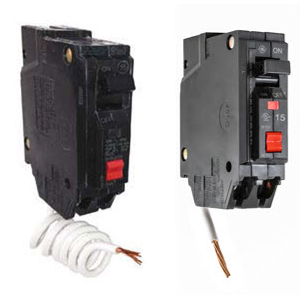
When everything is operating correctly, the current in both lines should be precisely equal. While the hotline combines directly with GND (for example, if somebody touches the hotline accidentally), the current value surges in the hotline but not in the neutral line. So, the GFCI stops the system as soon as this occurs, avoiding the electrocution process. The GFCI behaves much more immediately than a common circuit breaker because it doesn’t have to wait for the value of the current to rise to unsafe rates.
All the wiring sections in a building operate based on the central panel of the circuit breaker (or fuse box section), commonly in the closet or the basement. A usual central panel consists of a dozen circuit breakers for monitoring various circuits in the house. One circuit might contain all of the living room outlets, and another might contain all of the lighting systems downstairs. Larger appliances like the central air conditioning setup or a refrigerator are commonly based on their own circuit.
How Excessive Current Builds Up in a Circuit?
The operation of the circuit breaker is not that complex of a study. Because its operation is relatively simple, and the performance is even easier to define, so let us begin with the fundamental principle of Ohms Law. We understand that when voltage is obtained to some circuit, a current is generated in that system. The load to which that current has to be supported operates as a resistive arrangement and provides some resistance to the current network to restrict the amount of the current flowing so that it can run safely and not cause any problems.
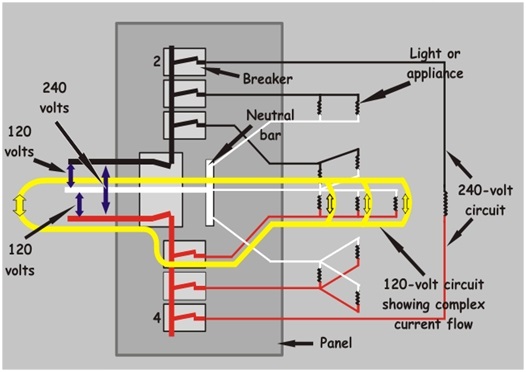
Additional current only moves in particular conditions, when one or more circuit components fail to operate or perform improperly, or any section of the line gets damaged. Then, the resistance value reduces, and a very large amount of current moves within the circuit, which can cause heating up or damage to the circuit elements. Circuit breakers are employed to prevent this greater amount of current from entering the system.
How does a Circuit Breaker Work & Stop the Excessive Current from Flowing?
The operation of a circuit breaker is less or more similar to a fuse, as far as effective performance is concerned. But the main difference lies in the fact that the fuse should be replaced every cycle when a great amount of current wants to move through it. This high current damages its internal structure. So here lies the major benefit of the circuit breaker, it practically requires no replacement. To explore more about this concept, just consider its main structure which is somewhat as follows:
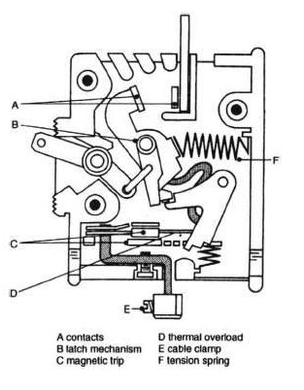
It has an electromagnet that becomes energized or de-energized by the flowing current. If the current passing lies within a safe working level, the electromagnet part cannot energize, and the metallic blade whose one end is combined with the electromagnet and the other to the stationary contact is further connected to the next section of the circuit, holds its contact, and the current simply passes within the circuit breaker to the external circuitry.
When the current exceeds the safe working level and becomes very great according to some fault in the system, the electromagnet section will finally get energized. This power will be extra enough to break the contact of the metallic section from the main contact, which is connected to the external circuit.
In this situation, the circuit opens from this part, and the current path quickly faces an infinite value of resistance and is unable to move ahead. When the current reduces back, the electromagnet section is de-energized, and the contact is kept again, so the circuit performs safely.
This was all about the operation of the circuit breaker and the answer to this basic question: How does a Circuit Breaker Work? In our next post, we are going to tell you further about the differences between a circuit breaker and a fuse so that it becomes easier for you to select which one to use.
Buy Equipment or Ask for a Service
By using Linquip RFQ Service, you can expect to receive quotations from various suppliers across multiple industries and regions.
Click Here to Request a Quotation From Suppliers and Service Providers
Read More on Linquip
- Difference Between Isolator and Circuit Breaker: Ultimate Guide
- The 8 Best Circuit Breaker Locators in 2022
- What is Resistive Circuit
- What is Linear Circuit
- What is Capacitive Circuit?
- What is RL Circuit
- What is RC Circuit?
- What is LC Circuit
- What is RLC Circuit
- Types of Capacitors: All You Need to Know
- What is a capacitor
- Difference Between Relay and Circuit Breaker: Everything You Need to Know

